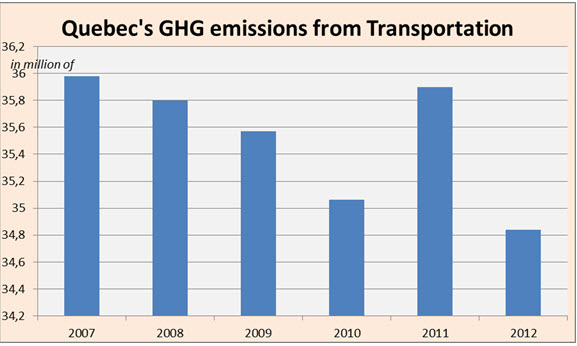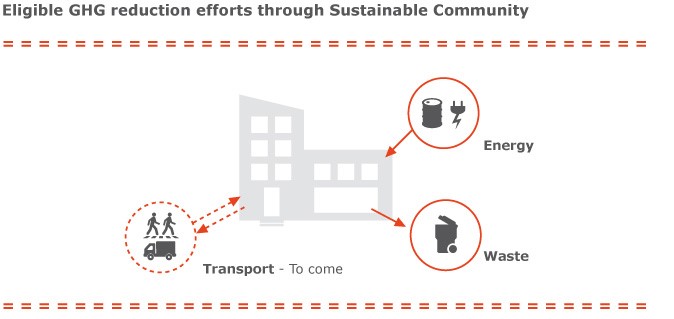Since 1990, the total fleet: of cars, light, medium and heavy trucks, increased significantly. By observing the trend from 2007 to 2012, we can observe that absolute GHG emissions from the transport sector have diminished with the exception of 2011.
Since 1990, the total fleet: of cars, light, medium and heavy trucks, increased significantly. By observing the trend from 2007 to 2012, we can observe that absolute GHG emissions from the transport sector have diminished with the exception of 2011. It would therefore be relevant to dissect total GHG emissions associated to transportation in Quebec and in particular during the last years. Further analysis may be useful in the subsequent implementation of measures and eco-mobility technologies. According to Wikipedia, the concept of eco-mobility is a term used to describe travel through integrated, socially inclusive, and environmentally friendly transport options, including and integrating walking, cycling, wheeling, and passaging. By enabling citizens and organizations to access goods, services, and information in a sustainable manner, it supports the citizen’s quality of life, increases travel choices, promotes social cohesion and cleaner environment resulting in smaller contributions in emissions of greenhouse gases. For 2010, the Intergovernmental Panel on Climate Change (IPCC) established the relative weight of worldwide anthropogenic greenhouse gas emissions caused by transportation at 14% or nearly 6.86 billion tons of GHGs. We might think that government policies, plans, taxes or carbon markets, since 2009, should have had a positive impact on reductions and yet there are some incongruities such as the explosion of travel such as business trips that are booming globally.

In 2012, Quebec’s relative weight in transport was 44.6% of an inventory of 77.98 million tons of GHG emissions . This latest data on the relative weight quickly leads us to conclude that we should all immediately jump into electric vehicles, have more carpooling, consider cars without drivers and increase public transport. The downward trend of transport emissions seems to continue in 2013, with data released by the Sector Management Chair of Energy HEC Montreal, which show a decrease of 1 % of these emissions for 2013 . What is the basis for such reductions?

It seems relevant to identify the sources of reduction in GHG emissions in the transport sector in relation to their motivation: i.e. travel to work and to receive services. In Quebec the active force of the population works less and less in agriculture, mining and manufacturing and more in services. This aspect should be taken into account in the deployment of eco-mobility solutions. Furthermore, digital connectivity of our society, teleworking and sustainable mobility seem to be a communicating vase with little analysis. This restricts the identification and analysis of solutions that are currently focused in a silo mode: GHG emission reduction solutions for transportation, others for industry, still others in waste management, etc.There is still much to analyze, to identify as valid paths and do everything by acting now in the hope that 5 or 6 good ideas will emerge. The change will not be linearly nor in silos (technology by technology), but by integrated approaches with synergy, stimulating and rewarding the change in behavior which is the true basis of any societal change. In this context, the consolidation of GHG reductions by building as a perimeter of the point of emission seems supporting: one can combine emission reductions and energy, waste and transport rather than focusing only on technologies silo by silo.

To comment our blog: blogs@solutionswill.com
Martin Clermont, CEO, Solutions Will

